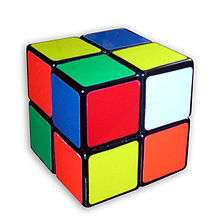Pocket Cube

The Pocket Cube (also known as the Mini Cube) is the 2×2×2 equivalent of a Rubik's Cube. The cube consists of 8 pieces, all corners.
History

In March 1970, Larry D. Nichols invented a 2×2×2 "Puzzle with Pieces Rotatable in Groups" and filed a Canadian patent application for it. Nichols's cube was held together with magnets. Nichols was granted U.S. Patent 3,655,201 on April 11, 1972, two years before Rubik invented his Cube.
Nichols assigned his patent to his employer Moleculon Research Corp., which sued Ideal in 1982. In 1984, Ideal lost the patent infringement suit and appealed. In 1986, the appeals court affirmed the judgment that Rubik's 2×2×2 Pocket Cube infringed Nichols's patent, but overturned the judgment on Rubik's 3×3×3 Cube.[1]
Permutations

Any permutation of the eight corners is possible (8! positions), and seven of them can be independently rotated (37 positions). There is nothing identifying the orientation of the cube in space, reducing the positions by a factor of 24. This is because all 24 possible positions and orientations of the first corner are equivalent due to the lack of fixed centers. This factor does not appear when calculating the permutations of N×N×N cubes where N is odd, since those puzzles have fixed centers which identify the cube's spatial orientation. The number of possible positions of the cube is
The maximum number of turns required to solve the cube is up to 11 half or quarter turns, or up to 14 quarter turns only.[2]
The number a of positions that require n any (half or quarter) turns and number q of positions that require n quarter turns only are:
| n | a | q | a(%) | q(%) |
|---|---|---|---|---|
| 0 | 1 | 1 | 0.000027% | 0.000027% |
| 1 | 9 | 6 | 0.00024% | 0.00016% |
| 2 | 54 | 27 | 0.0015% | 0.00073% |
| 3 | 321 | 120 | 0.0087% | 0,0033% |
| 4 | 1847 | 534 | 0.050% | 0.015% |
| 5 | 9992 | 2256 | 0.27% | 0.061% |
| 6 | 50136 | 8969 | 1.36% | 0.24% |
| 7 | 227536 | 33058 | 6.19% | 0.90% |
| 8 | 870072 | 114149 | 23.68% | 3.11% |
| 9 | 1887748 | 360508 | 51.38% | 9.81% |
| 10 | 623800 | 930588 | 16.98% | 25.33% |
| 11 | 2644 | 1350852 | 0.072% | 36.77% |
| 12 | 0 | 782536 | 0% | 21.3% |
| 13 | 0 | 90280 | 0% | 2.46% |
| 14 | 0 | 276 | 0% | 0.0075% |
The two-generator subgroup (the number of positions generated just by rotations of two adjacent faces) is of order 29,160.[3]
Methods
A pocket cube can be solved with the same methods as a 3x3x3 Rubik's cube, simply by treating it as a 3x3x3 with solved (invisible) centers and edges. More advanced methods combine multiple steps and require more algorithms. These algorithms designed for solving a 2x2x2 cube are often significantly shorter and faster than the algorithms one would use for solving a 3x3x3 cube.
The Ortega method,[4] also called the Varasano method,[5] is an intermediate method. First a face is built (but the pieces may be permuted incorrectly), then the last layer is oriented (OLL) and lastly both layers are permuted (PBL). The Ortega method requires a total of 12 algorithms.
The CLL method[6] first builds a layer (with correct permutation) and then solves the second layer in one step by using one of 42 algorithms.[7]
The most advanced method is the EG method,[8] named after Eric Gunner. It also starts by building a layer (in any permutation), but then solves the rest of the puzzle in one step. It requires knowing 128 algorithms, 42 of which are the CLL algorithms.
World records

The world record solve is 0.49 seconds, set by Maciej Czapiewski of Poland on 20 March 2016 at Grudziądz Open 2016.[9]
The world record average of 5 solves (excluding fastest and slowest) is 1.35 seconds, also set by Maciej Czapiewski on 24 February 2018 at Warsaw Cube Masters 2018, with the times 1.25, (1.14), 1.31, (2.00) and 1.50 seconds.[10]
Top 5 solvers by single solve
| Name | Fastest solve | Competition |
|---|---|---|
| Maciej Czapiewski | 0.49s | Grudziądz Open 2016 |
| Michał Rzewuski | 0.52s | Grudziądz Open 2016 |
| Mats Valk | 0.56s | Kaohsiung Open 2016 |
| Rami Sbahi | 0.58s | Canadian Open 2015 |
| Kim Roger Høyland Larsen | 0.58s | Sandnes Open 2016 |
Top 5 solvers by average of 5 solves
| Name | Fastest average | Competition |
|---|---|---|
| Maciej Czapiewski | 1.35s | Warsaw Cube Masters 2018 |
| Kevin Gerhardt | 1.37s | Hessen Open 2018 |
| Will Callan | 1.39s | Tea Time Spring 2018 |
| Rami Sbahi | 1.45s | Michigan 2017 |
| Andy Denney | 1.48s | Coach Pigeon 2018 |
See also
- Rubik's Cube (3×3×3)
- Rubik's Revenge (4×4×4)
- Professor's Cube (5×5×5)
- V-Cube 6 (6×6×6)
- V-Cube 7 (7×7×7)
- V-Cube 8 (8×8×8)
- Combination puzzles
- WOWCube (2×2×2)
References
- ↑ "Moleculon Research Corporation v. CBS, Inc". Digital-law-online.info. Retrieved 2012-06-20.
- ↑ Jaapsch.net: Pocket Cube
- ↑ http://sporadic.stanford.edu/bump/match/morepolished.pdf
- ↑ Ortega method tutorial by Bob Burton
- ↑ What is Varasano?
- ↑ What is CLL?
- ↑ CLL tutorial by Christopher Olson
- ↑ Description of the EG method
- ↑
- ↑ World Cube Association Official Results – 2×2×2 Cube.
